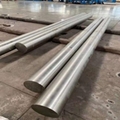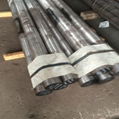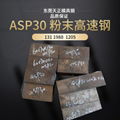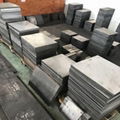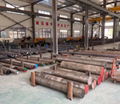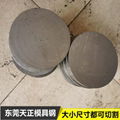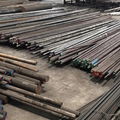| Model: | 70Mn15Cr2AI3V2W |
|---|---|
| Brand: | - |
| Origin: | Made In China |
| Category: | Metallurgy , Mining & Energy / Metallurgy & Mining / Other Metallic |
| Label: | HPM75 , 70Mn15 , Non-magnetic die ste |
| Price: |
¥15
/ KG
|
| Min. Order: | 1 KG |
Product Description
70Mn15Cr2AI3V2WMo is a new type of non-magnetic die steel, which is widely used in magnetic material production industry. The steel is a high manganese austenitic steel, which can maintain stable austenitic structure under various states, with very low magnetic conductivity and high hardness, strength and wear resistance. Because high manganese steel has obvious cold working hardening phenomenon, cutting is more difficult, and easy to damage the tool. In spite of this, the hardness value is far from meeting the high hardness requirements of the die. In addition, due to the austenite structure of the steel. It is quite stable and cannot be hardened to improve its hardness. Through our many tests and practical use, the steel can be processed according to the following processing route, which can improve the cutting performance of steel and improve the hardness of the die. The processing route is: forging - - annealing - cutting - solution treatment - - aging treatment - - grinding and grinding - - > surface chromium plating
Two, forging process
70Mn15Cr2Al3V2WMo non-magnetic die steel has poor thermal conductivity, so the temperature in the forging heating fashion furnace should not be too high, and should be slowly heating up. The forging heating temperature is 1170~1180°C, the holding time is more than 8 h, so that the carbide in the steel can be fully solid solution, change the thermoplasticity of ordinary steel. The opening forging temperature is about 1100° c, and the final forging temperature is greater than 950C. After forging, it is cooled in the air. The hardness of steel at this time is HRC34~35.
Three, annealing process
General austenitic steel can obtain lower hardness by solution treatment directly after forging, and can be machined after solution treatment. But for high manganese austenitic steel, due to cold
In the work hardening is more serious, the cutting performance of steel in the solid solution state is very poor, the need for high temperature annealing, that is, between 870~890C insulation for 3~6 h, and then the furnace cooling to below 500C, and then in the air cooling. High temperature annealing will improve the precipitation of carbides from austenite
Chip breaking performance during cutting, and reduce work hardening phenomenon. The hardness of the steel after annealing is HRC 28~29, and the microstructure of the steel after annealing is fine grain austenite and uniformly distributed granular carbides.
Iv. Solution treatment process
Non-magnetic die steel can be treated with solution after annealing and cutting. The purpose of solution treatment is to dissolve alloying elements into matrix. For 70Mn15Cr2Al3V2WMo high manganese austenitic steel, the solution temperature should be higher and the time should be longer. When the solution temperature is lower than 1170°C, the carbide is not dissolved sufficiently, and after the aging treatment, the hardness is lower. When the solution temperature is at 1200C, the austenite grains become quite coarse (grade 6), which affects the toughness of the steel. Solution treatment temperature should be controlled in the range of 1170~1180C.
Due to the low thermal conductivity of this kind of steel, the solution heating should be especially slow to prevent its deformation and cracking. If salt bath furnace solution treatment, it is best to carry out secondary preheating. The high temperature holding time should be enough during solution. If the smell is not enough, the alloy elements are not completely dissolved, which will also affect the aging effect in the future. Usually, the salt bath furnace treatment, its holding time is 15~20h, the air furnace treatment, its holding time is 30h. Use water cooling after heat preservation. After solution treatment, the hardness of steel is HRC20~22.
In addition, due to the solution treatment temperature is higher, the time is longer, so in the heating process should prevent the material surface oxidation and decarburization, otherwise the decarburization layer in the subsequent cooling process will have part of the austenite into martensite, so that it has ferromagnetic. In addition, the product Fe2O is generated after oxidation. And FesO. They are also ferromagnetic. These will destroy the non-magnetic die steel in the magnetic field is not magnetized. Therefore, high temperature solution must be carried out strictly in neutral atmosphere, preferably in salt bath furnace or protective atmosphere furnace.
Five, aging process
The hardness of 70Mn15Cr2AI3V2WMo non-magnetic die steel is low after solution treatment, and must be aging treatment to obtain the required hardness. The hardness is increased because the carbide precipitates dispersedly during aging. At the beginning of aging, the hardness of steel increases sharply with the increase of aging time, and there is a peak value of aging hardening at different solution temperatures. When aging at 700C, the hardening peak at 2h. Now, at 650C aging, the hardening peak appears at 20h, that is, with the decrease of aging temperature, the hardening peak time appears backward. The peak value of age hardening is between HRC47 and 49. The aging temperature is usually 700C or 650C. The effects of aging temperature and smell on steel hardness are shown in Figure 1. In order to improve the surface hardness and wear resistance of the die, after the final grinding and grinding of the die, the surface of the die can be plated with hard inscription. The thickness of chromium plating is usually about 0.05mm.
Sixth, concluding remarks.
70Mn15Cr2AI3V2WMo non-magnetic die steel after forging, annealing, solution and aging treatment, not only can improve its machinability, and the hardness can be increased to HRC47~49, so as to ensure the performance of the die. 70Mn15Cr2AI3V2WMo is a new type of non-magnetic die steel, its processing and heat treatment process is still in the exploratory stage, the new process provides a useful experience for improving the cutting performance and service performance of the steel.
Member Information
| Country/Region: | Guang Dong - China |
|---|---|
| Business Nature: | Trading Company |
| Phone: | 13192036165 |
| Contact: | |
| Last Online: | 05 Dec, 2021 |
Related Products of this Company
-
4J29 KOVAR Precision alloy Metals,
US $30
-
What is S7 steel made of
US $5
-
HPM75 round steel without magnetic steel
US $10
-
Non-magnetic die steel HPM75 for
US $20
-
Nitronic60 Stainless Steel
US $10
-
7MN15CR2AL3V2WMO non-magnetic steel
US $20
-
HPM75Non-magnetic die steel
US $10
-
HPM75 non-magnetic die steel
US $20
-
7Mn15 non-magnetic die steel
-
Stainless steel N690
US $10



